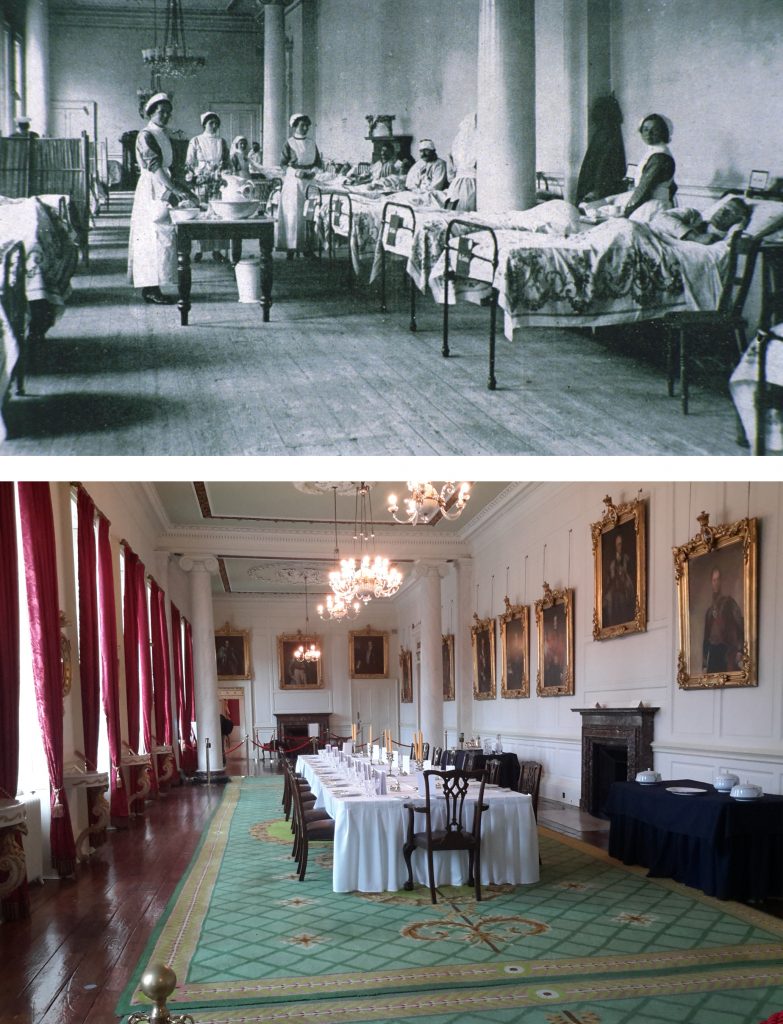DUBLIN CASTLE’S VICEREGAL APARTMENTS AS A RED CROSS MILITARY HOSPITAL (1915–19)
Published in Issue 4 (July/August 2016), News, Volume 24By Sylvie Kleinman

Above: Dublin Castle’s Portrait Gallery in May 1916 and now (inset). (Imperial War News; OPW)
Mary Josephine Wogan from Enniskerry, a paternal aunt of Terry, became a nurse’s assistantthere at 22 and claimed to have treated Connolly; with irony,she later said that they had made him ‘well enough’ to be taken to Kilmainham to be executed.Another (anonymous) Voluntary Aid Detachment nurse, without naming the unarmed DMP Constable James O’Brien(the first fatality of 1916), referred to him as ‘their favourite…the nicest, with twinkly eyes’, who always saluted the nurses when they passed in uniform. During the first few hours of fear and anxiety, then the constant firing, she described how the windows of the Portrait Gallery and the Throne Room (directly facing the main gate) were ‘throngedwith spectators’; a few rebels even entered the yard, had a lookand then retreated to City Hall. Although there were only about 40 patientsduring the Rising, tensions ran high and the patients became agitated, as‘guns were firing on three sides of us’. They had been ordered to blackout the hospital, which soon took in wounded soldiers, rebels and civilians alike. One amputee still covered with shrapnel splinters, the only man in his unit at the front to survive ashell burst, mused that if they broke in they could get him, since he couldn’t run away. Because of the danger of straybullets, beds were moved for a time inside to the ballroom (St Patrick’s Hall) and the corridor.Though clearly unsympathetic to the rebels, the nurse’s observations are also sharp and a welcome record, e.g. on injured and innocent female civilians, like the servant from the Metropole Hotel. Two wounded ‘Sinn Féiners’ were assigned beds in the Throne Room, but no black humour ensued. A press photo of this soon redundant space shows a bed under the dais in lieu of George IV’s majestic throne; while not wishing to trivialise the suffering witnessed here, one regrets that O’Casey or Shaw had not penned some plausible banter between the patient assigned to this bed and the staff.Connolly’s arrival caused ‘an unusual stir’, and he was eventually brought up to ‘a small ward in the officer’s quarter where he could be carefully guarded’, and court-martialled in his hospital bed; the scene is now recreated with respectful understatement.
Evidently a major demonstration of Ireland’s involvement in the Great War, the Castle hospitalbrings to the fore not only the response by medical professionalsbut also women’s voluntary war work, a first in Irish history. Lady Aberdeen had already campaigned tirelessly against tuberculosis (some referred to her as ‘Lady Microbe’)and became president of the first City of Dublin branch of the [British] Red Cross Society in late 1914; she had hoped to form an Irish branch, as many nationalist womeninvolved in the Women’s National Health Associationyearned for training. A scheme to build pavilions in the Phoenix Park and provide auxiliary hospitals was deemed too costly, so she had suggested a solution to the viceroy. That George V had stayed in the Castle in 1911, on what would be the last royal visit before independence, turned out to be beneficial to ‘subsequent occupants of that historic edifice’ during its unforeseen use as a hospital, Lady Aberdeen recalled, as ‘internal arrangements with regard to sanitation had been far from satisfactory’. Details of inspection visits by eminent medics in late 1914 reveal a spine-chilling coincidence stretching back to the last rebellion. They were led by Sir John Lentaigne, the Castle ‘physician-in-ordinary’; he was none other than the grandson of Dr Benjamin Lentaigne, who had attended Theobald Wolfe Tone in his cell in November 1798.
On a lighter note, St Patrick’s Hallbecame the recreation room and was filled with billiard-tables and ‘other games’ (probably card-tables). Every Thursday the Tivoli Theatre brought in performers from music halls to entertain the Castle soldiers, as well asmenbrought from other military hospitals around the city. With its imperial purpose about to end, the magnificent gilded ballroomfrequented until then only by the élite was totally redefined by the medical emergency of the war.
Sylvie Kleinman is a research fellow at the Dept of History, Trinity College, Dublin, and an OPW guide and Information and Education Officer at Dublin Castle.
















